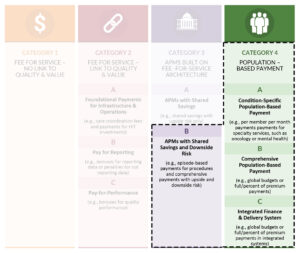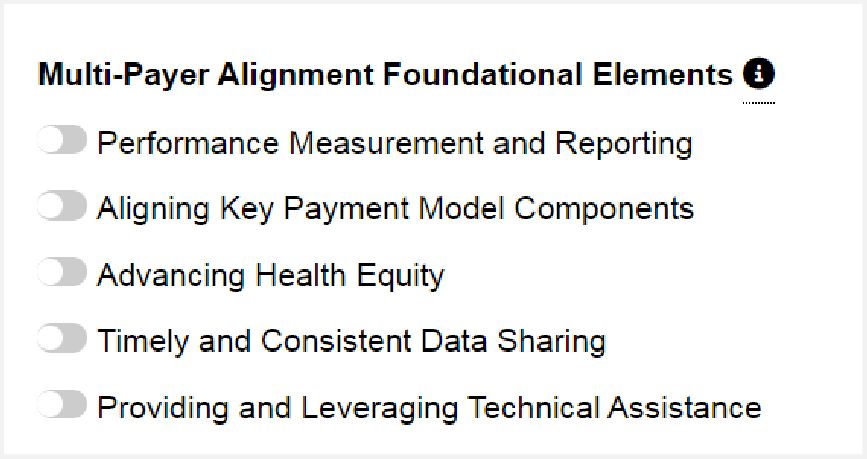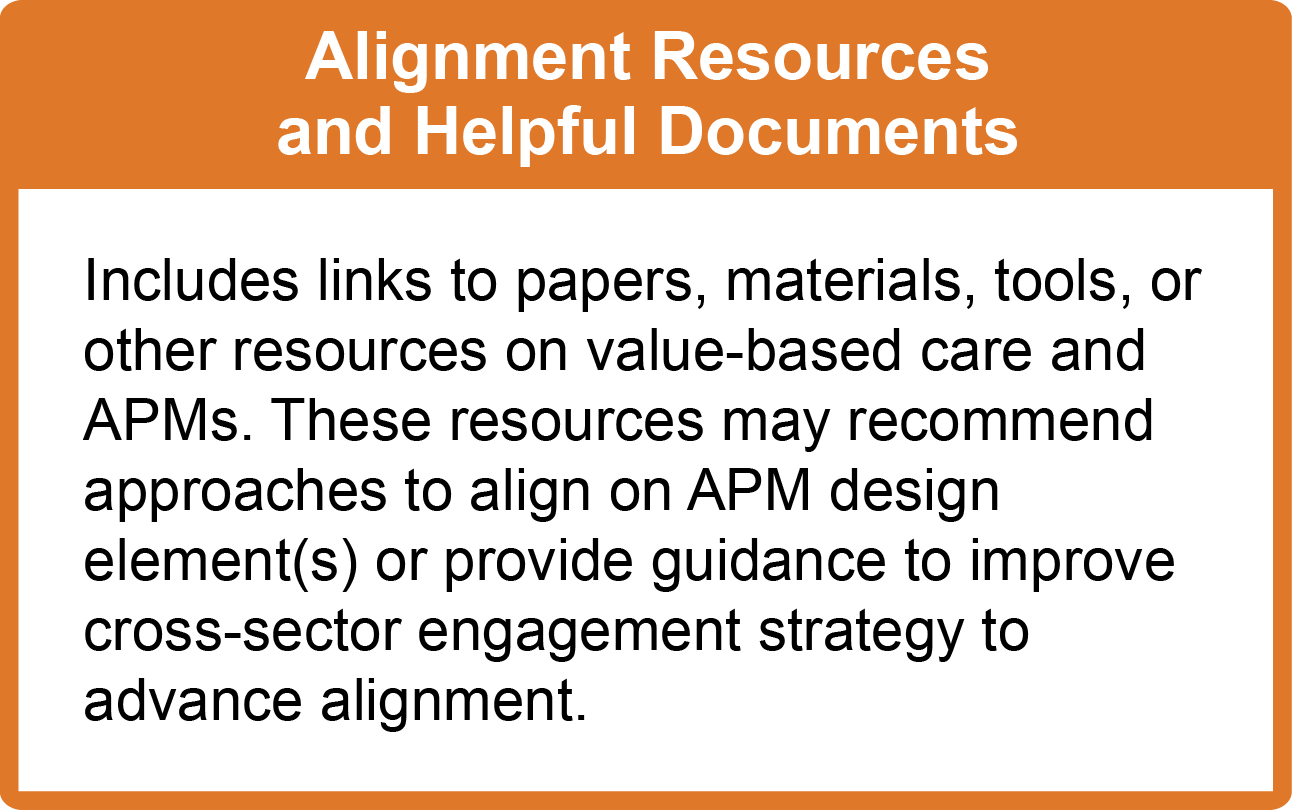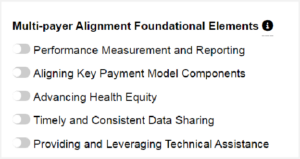HCPLAN GOAL STATEMENT FAQs
The Health Care Payment Learning & Action Network (HCPLAN) is committed to advancing key objectives for the health care system: higher quality care, enhanced patient experience, and greater health equity at lower cost. The HCPLAN views the adoption of downside risk alternative payment models (APMs) as key to these objectives and recognizes that different markets and lines of business are progressing at different rates. To that end, the HCPLAN has established goals for the adoption of downside risk APMs.
OUR GOAL STATEMENT
Accelerate the percentage of U.S. health care payments tied to quality and value in each market segment through the adoption of downside risk alternative payment models, which are defined in detail as Categories 3B and 4 of the HCPLAN APM Framework. See a summary of these categories in the figure below.

Source: HCPLAN APM Framework
WHAT IS THE DIFFERENCE BETWEEN "UPSIDE SAVINGS" AND "DOWNSIDE RISK"?
Upside savings and downside risk are financial mechanisms used in accountable care to incentivize health care providers to deliver high-quality, cost-effective care. Upside savings (Category 3A) allows providers to keep additional payments or share in savings if they reduce costs while maintaining or improving care quality. Conversely, downside risk (Category 3B) requires providers to incur a financial loss and possibly repay a portion of the loss if they exceed cost targets or fail to meet quality benchmarks. Together, these two arrangements provide options to providers based on a variety of factors, encouraging them to optimize care and control costs to achieve financial and clinical success.
HOW DID THE HCPLAN COME UP WITH ITS 2030 APM GOALS?
The 2030 HCPLAN goals are based on the adoption of downside risk APMs (Categories 3B and 4) across the four lines of business: commercial, Medicaid, Medicare Advantage, and Traditional Medicare. Definitions for APM Categories 3B and 4 are detailed in the HCPLAN APM Framework and summarized in the figure below. The HCPLAN defined these goals based on past APM adoption survey results and analysis as well as feedback sessions with partner organizations.

Source: HCPLAN APM Framework
HOW DOES THE HCPLAN MEASURE AND REPORT ON APM MODELS WITH DOWNSIDE RISK?
As part of its annual Measurement Effort, the HCPLAN invites state Medicaid agencies and health plans across market segments to report total in- and out-of-network health care spending paid to providers through each of the categories and subcategories in the most recent 12 months in the commercial, Medicaid, and Medicare Advantage markets. Participating plans and states categorize payments according to the HCPLAN’s APM Framework using the HCPLAN survey tool, definitions, and methodology. Downside risk APMs correspond to results for Categories 3B and 4. Find more information on this approach on the Data Collection Process page and view results from past annual HCPLAN Measurement Efforts on the Measurement Efforts Results page.
WHY IS IT IMPORTANT TO MEASURE APM ADOPTION BY LINE OF BUSINESS?
Measuring APM adoption by line of business is crucial because each line faces unique challenges and exhibits varying adoption rates. The HCPLAN recognizes this variability and has established specific goals for each line of business to effectively monitor progress and develop tailored strategies and solutions.


















 Emily DuHamel Brower, M.B.A., is senior vice president of clinical integration and physician services for Trinity Health. Emphasizing clinical integration and payment model transformation, Ms. Brower provides strategic direction related to the evolving accountable healthcare environment with strong results. Her team is currently accountable for $10.4B of medical expense for 1.6M lives in Medicare Accountable Care Organizations (ACOs), Medicare Advantage, and Medicaid and Commercial Alternative Payment Models.
Emily DuHamel Brower, M.B.A., is senior vice president of clinical integration and physician services for Trinity Health. Emphasizing clinical integration and payment model transformation, Ms. Brower provides strategic direction related to the evolving accountable healthcare environment with strong results. Her team is currently accountable for $10.4B of medical expense for 1.6M lives in Medicare Accountable Care Organizations (ACOs), Medicare Advantage, and Medicaid and Commercial Alternative Payment Models. Mr. James Sinkoff is the Deputy Executive Officer and Chief Financial Officer for Sun River Health (formerly known as Hudson River HealthCare), and the Chief Executive Officer of Solutions 4 Community Health (S4CH); an MSO serving FQHCs and private physician practices.
Mr. James Sinkoff is the Deputy Executive Officer and Chief Financial Officer for Sun River Health (formerly known as Hudson River HealthCare), and the Chief Executive Officer of Solutions 4 Community Health (S4CH); an MSO serving FQHCs and private physician practices. Victor is the Chief Medical Officer for TennCare, Tennessee’s Medicaid Agency. At TennCare, Victor leads the medical office to ensure quality and effective delivery of medical, pharmacy, and dental services to its members. He also leads TennCare’s opioid epidemic strategy, social determinants of health, and practice transformation initiatives across the agency. Prior to joining TennCare, Victor worked at Evolent Health supporting value-based population health care delivery. In 2013, Victor served as a White House Fellow to the Secretary of Health and Human Services. Victor completed his Internal Medicine Residency at Emory University still practices clinically as an internist in the Veteran’s Affairs Health System.
Victor is the Chief Medical Officer for TennCare, Tennessee’s Medicaid Agency. At TennCare, Victor leads the medical office to ensure quality and effective delivery of medical, pharmacy, and dental services to its members. He also leads TennCare’s opioid epidemic strategy, social determinants of health, and practice transformation initiatives across the agency. Prior to joining TennCare, Victor worked at Evolent Health supporting value-based population health care delivery. In 2013, Victor served as a White House Fellow to the Secretary of Health and Human Services. Victor completed his Internal Medicine Residency at Emory University still practices clinically as an internist in the Veteran’s Affairs Health System. Dr. Brandon G. Wilson, DrPH, MHA (he, him, his) joined Community Catalyst as the Director of the Center for Consumer Engagement in Health Innovation, where he leads the Center in bringing the community’s experience to the forefront of health systems transformation and health reform efforts, in order to deliver better care, better value and better health for every community, particularly vulnerable and historically underserved populations. The Center works directly with community advocates around the country to increase the skills and power they have to establish an effective voice at all levels of the health care system. The Center collaborates with innovative health plans, hospitals and providers to incorporate communities and their lived experience into the design of systems of care. The Center also works with state and federal policymakers to spur change that makes the health system more responsive to communities. And it provides consulting services to health plans, provider groups and other health care organizations to help them create meaningful structures for engagement with their communities.
Dr. Brandon G. Wilson, DrPH, MHA (he, him, his) joined Community Catalyst as the Director of the Center for Consumer Engagement in Health Innovation, where he leads the Center in bringing the community’s experience to the forefront of health systems transformation and health reform efforts, in order to deliver better care, better value and better health for every community, particularly vulnerable and historically underserved populations. The Center works directly with community advocates around the country to increase the skills and power they have to establish an effective voice at all levels of the health care system. The Center collaborates with innovative health plans, hospitals and providers to incorporate communities and their lived experience into the design of systems of care. The Center also works with state and federal policymakers to spur change that makes the health system more responsive to communities. And it provides consulting services to health plans, provider groups and other health care organizations to help them create meaningful structures for engagement with their communities. Tamara Ward is the SVP of Insurance Business Operations at Oscar Health, where she leads the National Network Contracting Strategy and Market Expansion & Readiness. Prior to Oscar she served as VP of Managed Care & Network Operations at TriHealth in Southwest Ohio. With over 15 years of progressive health care experience, she has been instrumental driving collaborative payer provider strategies, improving insurance operations, and building high value networks through her various roles with UHC and other large provider health systems. Her breadth and depth of experience and interest-based approach has allowed her to have success solving some of the most complex issues our industry faces today. Tam is passionate about driving change for marginalized communities, developing Oscar’s Culturally Competent Care Program- reducing healthcare disparities and improving access for the underserved population. Tamara holds a B.A. from the University of Cincinnati’s and M.B.A from Miami University.
Tamara Ward is the SVP of Insurance Business Operations at Oscar Health, where she leads the National Network Contracting Strategy and Market Expansion & Readiness. Prior to Oscar she served as VP of Managed Care & Network Operations at TriHealth in Southwest Ohio. With over 15 years of progressive health care experience, she has been instrumental driving collaborative payer provider strategies, improving insurance operations, and building high value networks through her various roles with UHC and other large provider health systems. Her breadth and depth of experience and interest-based approach has allowed her to have success solving some of the most complex issues our industry faces today. Tam is passionate about driving change for marginalized communities, developing Oscar’s Culturally Competent Care Program- reducing healthcare disparities and improving access for the underserved population. Tamara holds a B.A. from the University of Cincinnati’s and M.B.A from Miami University.


 Dr. Peter Walsh joined the Colorado Department of Health Care Policy and Financing as the Chief Medical Officer on December 1, 2020. Prior to joining HCPF, Dr. Walsh served as a Hospital Field Representative/Surveyor at the Joint Commission, headquartered in Oakbrook Terrace, Illinois.
Dr. Peter Walsh joined the Colorado Department of Health Care Policy and Financing as the Chief Medical Officer on December 1, 2020. Prior to joining HCPF, Dr. Walsh served as a Hospital Field Representative/Surveyor at the Joint Commission, headquartered in Oakbrook Terrace, Illinois.








